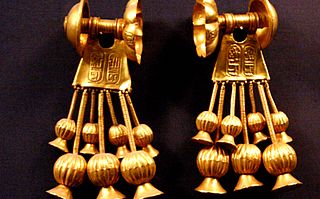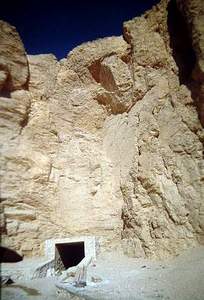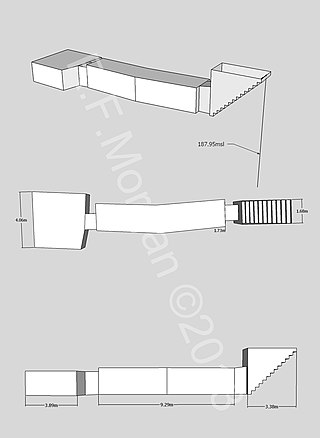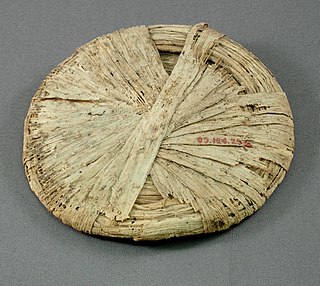
Tomb KV5 is a subterranean, rock-cut tomb in the Valley of the Kings. It belonged to the sons of Ramesses II. Though KV5 was partially excavated as early as 1825, its true extent was discovered in 1995 by Kent R. Weeks and his exploration team. The tomb is now known to be the largest in the Valley of the Kings. Weeks' discovery is widely considered the most dramatic in the valley since the discovery of the tomb of Tutankhamun in 1922.

Tomb WV22, also known as KV22, was the burial place of the Eighteenth Dynasty pharaoh Amenhotep III. Located in the Western arm of the Valley of the Kings, the tomb is unique in that it has two subsidiary burial chambers for the pharaoh's wives Tiye and Sitamen. It was officially discovered by Prosper Jollois and Édouard de Villiers du Terrage, engineers with Napoleon's expedition to Egypt in August 1799, but had probably been open for some time. The tomb was first excavated by Theodore M. Davis, the details of which are lost. The first documented clearance was carried out by Howard Carter in 1915. Since 1989, a Japanese team from Waseda University led by Sakuji Yoshimura and Jiro Kondo has excavated and conserved the tomb. The sarcophagus is missing from the tomb. The tomb's layout and decoration follow the tombs of the king's predecessors, Amenhotep II (KV35) and Thutmose IV (KV43); however, the decoration is much finer in quality. Several images of the pharaoh's head have been cut out and can be seen today in the Louvre.

KV20 is a tomb in the Valley of the Kings (Egypt). It was probably the first royal tomb to be constructed in the valley. KV20 was the original burial place of Thutmose I and later was adapted by his daughter Hatshepsut to accommodate her and her father. The tomb was known to the Napoleonic expedition in 1799 and had been visited by several explorers between 1799 and 1903. A full clearance of the tomb was undertaken by Howard Carter in 1903–1904. KV20 is distinguishable from other tombs in the valley, both in its general layout and because of the atypical clockwise curvature of its corridors.

Tomb KV56, also known as the Gold Tomb, is a tomb located in the Valley of the Kings, near Luxor, Egypt. It was discovered by Edward R. Ayrton in January 1908 and contained what is thought to be the intact burial of a royal child from the late Nineteenth Dynasty. The burial and casket have disintegrated, leaving a thin layer of gold leaf and stucco in the original location. Most famously the tomb contained spectacular gold and silver jewellery including earrings, rings, silver bracelets with the names of Seti II and Twosret inscribed, and a pair of small silver gloves. The original occupant of this tomb is unknown but was possibly an Eighteenth Dynasty queen.

The area of the Valley of the Kings, in Luxor, Egypt, has been a major area of modern Egyptological exploration for the last two centuries. Before this, the area was a site for tourism in antiquity. This area illustrates the changes in the study of ancient Egypt. Starting as antiquity hunting, and ending as scientific excavation of the whole Theban Necropolis. Despite the exploration and investigation noted below, only eleven of the tombs have actually been completely recorded.

Tomb KV1, located in the Valley of the Kings in Egypt, was used for the burial of Pharaoh Ramesses VII of the Twentieth Dynasty. Although it has been open since antiquity, it was only properly investigated and cleared by Edwin Brock in 1984 and 1985. The single corridor tomb is located in Luxor's West Bank, and is small in comparison to other tombs of the Twentieth Dynasty.

Tomb KV3, located in Egypt's Valley of the Kings, was intended for the burial of an unidentified son of Pharaoh Ramesses III during the early part of the Twentieth Dynasty. It is similar in design to the "straight axis" tombs typical of this dynasty, and an ostracon written in hieratic script from the time of Ramesses III mentions the founding of a tomb for a royal prince, likely this tomb. The unfinished state of a couple of rooms in the tomb along with scant archeological evidence suggests that the tomb was never used. Some have suggested that it was originally intended for use by the prince regent who would succeed as Ramesses IV, and who started building his own tomb (KV2) soon after he came to the throne.

KV4 is a tomb in the Valley of the Kings (Egypt). The tomb was initiated for the burial of Ramesses XI but it is likely that its construction was abandoned and it was not used for Ramesses's interment. It also seems likely that Pinedjem I intended to usurp this tomb for his own burial, but that he too abandoned the plan. KV4 is notable for being the last royal tomb that was quarried in the Valley and because it has been interpreted as being a workshop used during the official dismantling of the royal necropolis in the early Third Intermediate Period.

Tomb KV18, located in the Valley of the Kings in Egypt, was intended for the burial of Pharaoh Ramesses X of the Twentieth Dynasty; however, because it was apparently abandoned while still incomplete and since no funerary equipment was ever found there, it is uncertain whether it was actually used for his burial.

Tomb KV47, located in the Valley of the Kings in Egypt, was used for the burial of Pharaoh Siptah of the Nineteenth Dynasty. It was discovered on December 18, 1905 by Edward R. Ayrton, excavating on behalf of Theodore M. Davis; Siptah's mummy had been found earlier, cached in KV35. It was the last of the Nineteenth and Twentieth Dynasty kings tombs to be uncovered in the Valley. Ayrton stopped his excavation in 1907 due to safety fears, and Harry Burton returned in 1912 to dig further. The cutting of a side passage was halted after the workmen cut into Side Chamber Ja of the tomb of Tia'a (KV32). The tomb was unfinished at the time of its use.

Tomb KV45 is an ancient Egyptian tomb located in the Valley of the Kings in Egypt. It was originally used for the burial of the noble Userhet of the Eighteenth Dynasty and was reused by Merenkhons and an unknown woman in the Twenty-second Dynasty. The tomb was discovered and excavated by Howard Carter in 1902, in his role as Chief Inspector of Antiquities, on behalf of Theodore M. Davis. The tomb was later re-investigated by Donald P. Ryan of the Pacific Lutheran University Valley of the Kings Project in 1991 and 2005.
Tomb KV29 is an ancient Egyptian tomb in the Valley of the Kings, located in the Theban Necropolis in Egypt. It is located near the mid-Eighteenth Dynasty tombs of Tiaa (KV32), Thutmose II or Merytre-Hatshepsut (KV42), and Thutmose III (KV34). The tomb was given the number KV29 in 1899 but no records of an earlier excavation exist. The entrance shaft was previously planned by the Theban Mapping Project prior to 1994. The tomb was first excavated by the University of Basel King's Valley Project in 2011.

Tomb KV37 is an ancient Egyptian tomb located in the Valley of the Kings in Egypt. The presence of bone fragments and white-washed storage jars indicate that the tomb was used for a burial, probably in the Eighteenth Dynasty. However, its original occupants are unknown.

KV44 is an ancient Egyptian tomb located in the Valley of the Kings, Egypt. It was discovered and excavated by Howard Carter in 1901 and was re-examined in 1991 by Donald P. Ryan. The single chamber accessed by a shaft contained three intact Twenty-second Dynasty burials; the remains of seven mummies from the original interment were found within the fill. The original cutting of the tomb is dated to the Eighteenth Dynasty.

Tomb KV27 is located in the Valley of the Kings in Egypt. This tomb was visited by John Wilkinson, but was not fully explored until the 1990s, by Donald P. Ryan of Pacific Lutheran University. The tomb consists of four rooms and is undecorated; nothing is known about its occupant.

Tomb KV58, known as the "Chariot Tomb", is located in the Valley of the Kings in Egypt. It was discovered in January 1909 by Harold Jones, excavating on behalf of Theodore M. Davis. The circumstances of the discovery and specifics of the excavation were only given a passing mention in Davis' account, who attributes the discovery to Edward Ayrton in 1907 instead. The tomb consists of a shaft leading to a single chamber and contained only embossed gold foil, furniture knobs, and a single ushabti. The contents likely originated from the Eighteenth Dynasty tomb of Ay in WV23. Davis considered this tomb to be the burial place of the then little-known pharaoh Tutankhamun.

Tomb KV50 is located in the Valley of the Kings, in Egypt. It was discovered in 1906 by Edward R. Ayrton excavating on behalf of Theodore M. Davis. Together with KV51 and KV52, it forms a group known as the "Animal Tombs". It contained the burial of a dog mummy and a mummified monkey and is probably associated with the nearby tomb of Amenhotep II (KV35).

Tomb KV54 is located in the Valley of the Kings, in Egypt. It was originally excavated by Edward R. Ayrton on behalf of the American lawyer Theodore M. Davis, who funded the work.

The Valley of the Kings, also known as the Valley of the Gates of the Kings, is a valley in Egypt where, for a period of nearly 500 years from the 16th to 11th century BC, rock-cut tombs were excavated for the pharaohs and powerful nobles of the New Kingdom.
The majority of the 65 numbered tombs in the Valley of the Kings can be considered minor tombs, either because at present they have yielded little information or because the results of their investigation was only poorly recorded by their explorers, while some have received very little attention or were only cursorily noted. Most of these tombs are small, often only consisting of a single burial chamber accessed by means of a shaft or a staircase with a corridor or a series of corridors leading to the chamber, but some are larger, multiple chambered tombs. These minor tombs served various purposes, some were intended for burials of lesser royalty or for private burials, some contained animal burials and others apparently never received a primary burial. In many cases these tombs also served secondary functions and later intrusive material has been found related to these secondary activities. While some of these tombs have been open since antiquity, the majority were discovered in the 19th and early 20th centuries during the height of exploration in the valley.


















